View in other NatureServe Network Field Guides
NatureServe
Montana
Utah
Wyoming
Idaho
Wisconsin
British Columbia
South Carolina
Yukon
California
New York
Garlic Glass-snail - Oxychilus alliarius
Other Names:
Helix alliaria, Zonitoides alliaria
General Description
A small shell, to 7 mm diameter and 3 mm in height but often smaller, flattened heliciform, smooth with some fine incremental striae, about 5-6 whorls, the last expanding to the aperture. Shell coloration is translucent amber brown on the upper surface, lighter on the undersurface. Aperture is large, oblique crescent-shaped, without teeth (denticles); periphery rounded; umbilicus about 1/6 the shell diameter. The animal is dark gray to blackish and emits a strong garlic odor when handled (Hendricks 2012, Burke 2013). Internal anatomy is described by Giusti and Manganelli (1997).
Diagnostic Characteristics
Oxychilus differ from other species by a combination of a generally smooth and translucent shell lacking a flared lip, no banding, an enlarged body whorl at the aperture less than half the diameter, a narrow umbillicus, a low to flattened spire. O. alliarius differs from O. draparnaudi by being smaller (8 mm diameter compared to 10-16 mm), having a very smooth and glossy shell, and possessing a strong garlic odor when disturbed.
Species Range
Montana Range
Range Descriptions

 Non-native
Non-native
Range Comments
Western Europe; introduced elsewhere, including North America. In Montana, only one report from Lee Metcalf National Wildlife Refuge, Ravalli County, west of the Continental Divide; elevation 991 m (3250 ft). First reported for Montana in 2009. Range and abundance poorly documented in Montana; current status needs investigation. Probably occurs in many additional urban settings and valley bottoms (Hendricks 2012).
Observations in Montana Natural Heritage Program Database
Number of Observations: 1
(Click on the following maps and charts to see full sized version)
Map Help and Descriptions
Relative Density
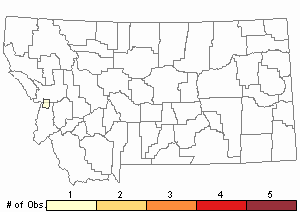
Recency
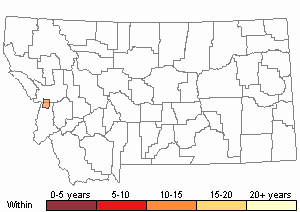
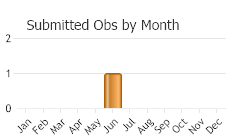
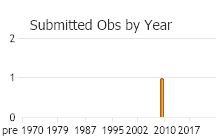
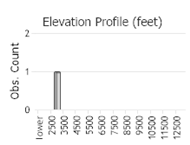 (Observations spanning multiple months or years are excluded from time charts)
(Observations spanning multiple months or years are excluded from time charts)
Habitat
Frequents moist sites in parks, gardens, and other modified habitats. Found at Lee Metcalf National Wildlife Refuge at the edge of a water-filled slough under woody debris, leaf litter, and grassy vegetation, with nearby black cottonwood canopy. Habitat in Montana poorly documented (Hendricks 2012).
Food Habits
Omnivorous.
Stewardship Responsibility
References
- Literature Cited AboveLegend:
 View Online Publication
View Online Publication Burke, T. E. 2013. Land snails and slugs of the Pacific Northwest. Corvallis, OR: Oregon State University Press. 344 p.
Burke, T. E. 2013. Land snails and slugs of the Pacific Northwest. Corvallis, OR: Oregon State University Press. 344 p. Giusti, F., and G. Manganelli. 1997. How to distinguish Oxychilus cellarius (Mueller, 1774) easily from Oxychilus draparnaudi (Beck, 1837) (Gastropoda, Pulmonata, Zonitidae). Basteria 61:43-56.
Giusti, F., and G. Manganelli. 1997. How to distinguish Oxychilus cellarius (Mueller, 1774) easily from Oxychilus draparnaudi (Beck, 1837) (Gastropoda, Pulmonata, Zonitidae). Basteria 61:43-56. Hendricks, P. 2012. A Guide to the Land Snails and Slugs of Montana. A report to the U.S. Forest Service - Region 1. Montana Natural Heritage Program, Helena, MT. vii + 187 pp. plus appendices.
Hendricks, P. 2012. A Guide to the Land Snails and Slugs of Montana. A report to the U.S. Forest Service - Region 1. Montana Natural Heritage Program, Helena, MT. vii + 187 pp. plus appendices.
- Additional ReferencesLegend:
 View Online Publication
View Online Publication
Do you know of a citation we're missing? Forsyth, R.G. 2004. Land snails of British Columbia. Royal British Columbia Museum: Victoria, British Columbia, Canada. 188 pp.
Forsyth, R.G. 2004. Land snails of British Columbia. Royal British Columbia Museum: Victoria, British Columbia, Canada. 188 pp. Frest, T.J. and E.J. Johannes. 2001. An annotated checklist of Idaho land and freshwater mollusks. Journal of the Idaho Academy of Science 36(2):1-51.
Frest, T.J. and E.J. Johannes. 2001. An annotated checklist of Idaho land and freshwater mollusks. Journal of the Idaho Academy of Science 36(2):1-51. Pilsbry, H.A. 1946. Land Mollusca of North America (north of Mexico), Volume II Part 1. Academy of Natural Sciences of Philadelphia Monograph Number 3 (2):1-520.
Pilsbry, H.A. 1946. Land Mollusca of North America (north of Mexico), Volume II Part 1. Academy of Natural Sciences of Philadelphia Monograph Number 3 (2):1-520.
- Web Search Engines for Articles on "Garlic Glass-snail"
- Additional Sources of Information Related to "Snails / Slugs"





